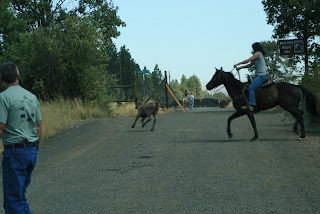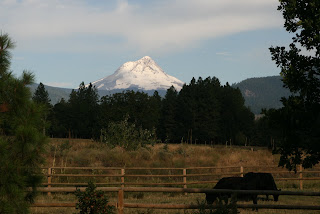When we learned we would be here when he moved the cattle, we knew we wanted to watch. Brian said they brought the cattle here by driving them down the road, but he thought they would take them back home by truck. However, about 1 pm yesterday the cowhands began arriving—10 men and women on horseback and one man on an ATV. Most of the horses were brought in by horse trailer. Two women rode their horses here.
When everyone was assembled and the route out of the field, through the wildlife area to the gate, then down the road was explained, they rode out across the field, driving the cows and calves around the back of the pond and toward an open spot in the fence. But nobody told the cows the fence was open, so they went right around the pond, back toward the open field. There were two cow dogs and I heard one of the men yelling to his dog, "back, back." The dog ran through the cows and attempted to turn the herd around.

Finally they got the cattle to stop and turn around. Once the cows realized the fence was open, they quickly left the field and were gone down the hill. They left so quickly, we decided to follow for awhile and see what happened next.

We caught up to them as they approached the wildlife area gate. There is a cattle guard on the road, but a large gate next to the road
was opened so the cows could go around. Most of them went the right way. However, some of Brian's calves ducked through the fence into the adjoining field where Larry has been grazing his cattle. We guess the calves saw those cows and grass and decided they liked it better there.

The cowhands stopped the herd on the road while Brian and another man went into Larry's herd to catch the calves. We have watched calf roping events at rodeos over the years and now we know the skills—picking up the calf and throwing it to the ground—used in the rodeo have practical value. Brian didn't rope the calves, but he did grab them by the legs and carry them, one at a time, out of the field—under the fence.

One calf decided it didn't want to leave our pasture and ran back up the road the way he had come. One woman on horseback and the man on the ATV—with some help from John—tried to stop the calf. 
Herding cows is dusty work. And many of the cowhands weren't dressed like the cowboys of old. But it sure was exciting to watch the roundup and cattle drive. It was a first for us.
































